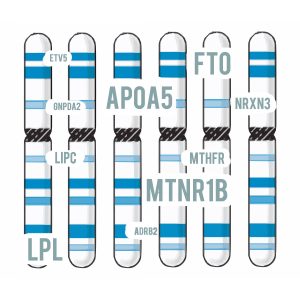So you decide to treat yourself and purchase GxSlim, our DNA-based health & fitness program. You open your test kit, swab the inside of your cheek, send your sample off to us, and voila! you have your personalized results paired with professional advice to help put you on your weight loss and fitness path. But what exactly do we look at in order to create such a personalized plan designed uniquely for you? Well, genes of course!
There are nearly 20,000 genes within any given person that code for specific traits. In order to create a unique analysis of your genetic makeup, we focus our testing on only 48 genetic markers, all of which have been scientifically proven to code for 16 genetic traits related to weight loss and overall health. Focusing on only a handful of genes allows us to give your more specific advice for your body and makes it a whole lot less overwhelming to take in and actually apply. So which genes do we look at? We thought you’d never ask!

FTO: also known as the fat mass and obesity-associated protein, the gene codes for an enzyme that has been linked to obesity. While it’s still notcertain exactly how this gene plays a role in obesity and weight loss, it’s proven that people who carry two copies of the allele tend to weigh around 7 pounds more than people who carry no copies at all. The thought is that expression of the FTO gene leads to a decrease in feeling rewarded after eating, meaning that people who express the gene may have a tendency to overeat and ultimately have a higher risk of being obese.
APOA5: this gene is responsible for plasma triglyceride levels, in other words it can help regulate the amount of fat in the body. People who don’t express this gene tend to utilize fat at a faster rate and can regulate their fat levels more efficiently than people who do express the gene.
LPL: this gene has been strongly associated with a person’s ability to lose fat through a consistent program of cardio exercise. Expression of the gene has been shown to inhibit fat loss, for whatever reason, meaning that your need to exercise more, or simply perform exercise other than cardio may be determined by the presence of this gene.
Here’s a few more genes we look at, in case you ever wanted to read up on some scientific literature about them…
TCF7L2, MTNR1B, PPARG, BDNF, ABCB11, APOA5, CRY2, MTNR1B, PPM1K, IRS1, MTHFR, BCMO1, NBPF3, FUT2, SLC23A1, GC, NADSYN1, CYP2R1, AMPD1, APOE, ADRB2, NRXN3, GNPDA2, LRRN6C, PRKD1, GPRC5B, SLC39A8, FLJ35779, MAP2K5, QPCTL-GIPR, NEGR1, LRP1B, MTCH2, MTIF3, RPL27A, EC16B, FAIM2, FANCL, ETV5, TFAP2B, LIPC
Overwhelming isn’t it? That’s why we only focus on a minuscule fraction of the genes present in your body. They’re the ones that are proven to play a role in health and fitness and have a large effect on body composition. You may have never heard of any of the genes before in your life (and probable never will hear about them again) but they play a large role in who you are and understanding them can help you on your wellness journey.

